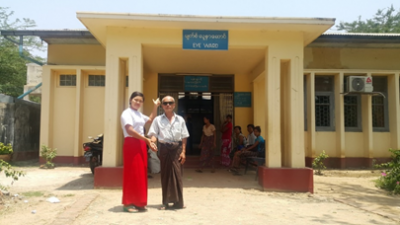Join a powerful, unprecedented alliance for better eye health for all.
Join IAPB-
Choose an alternate language here
With support from Seeing is Believing (SiB) and other development partners, Helen Keller International (HKI) has collaborated with the Myanmar Ministry of Health and Sports (MOHS) to achieve the VISION 2020 Right to Sight objectives. As a critical part of this effort, from 2015-2018 HKI’s SiB-supported Community-based Care and Restoration of Sight (CARROT) enabled vision screening for over 34,300 people and cataract surgery for over 22,400 clients, a 60% increase in the annual number of surgeries performed at the targetted rural clinics before the project. CARROT’s model for increasing the cataract surgical rate has now been integrated into Myanmar’s national eye care plan: a significant step as cataract accounts for almost 50% of blindness and vision loss.[1]
Alongside increasing the number of patients reached, HKI and the MOHS sought to increase the quality of surgery through training, supportive supervision and provision of improved surgical equipment and supplies. However, the MOHS lacked a system for tracking surgical outcomes, including visual acuity (VA), complications and the percentage of patients returning for recommended follow-up visits.

HKI and SiB recognized that monitoring surgical outcomes was critical to assessing program impact and providing targeted supervision and training to health facility staff to ensure they achieved outcomes per the WHO standard (post operative visual acuity 6/6 – 6/18 with available correction of more than 80%). Monitoring also allows surgeons and healthcare administrators to better self-assess weaknesses, resulting in better patient care. This, in turn, reduces patients’ fear about surgery, particularly when outcome data is shared with them.
As a first step in addressing this gap, HKI convened a meeting with key MOHS stakeholders to present the computerized MCSO-Monitoring Cataract Surgical Outcome Software. While surgeons acknowledged that monitoring surgical outcomes was critical, they also unanimously agreed that the software, or any similar computerized system, was too sophisticated for rural eye health facilities. In response to this feedback, HKI developed a paper-based monitoring tool based on the method developed by the Kwa-Zulu Prevention of Blindness Program in South Africa.[2] This simple tool includes two forms completed at patient discharge and eight week follow-up visits. Information collected includes IOL insertion, complications, VA and causes of poor outcomes.
Eye health staff in rural Myanmar, who began using the forms in 2018, report that this manual system is simple, easy to use and suitable for any rural health facility that does not have a computer system or staff with computer skills. However, challenges around data collection remain. While ophthalmologists record the required data they often do not have time to transfer it into the formats. The time constraint could be addressed by encouraging surgeons to delegate data collection tasks to other staff, although there is a general reluctance to do so. Additionally, the paper-based record system makes it difficult for staff to match patient records over multiple visits. In order to get a complete picture of each patient’s progress, HKI staff have assisted health center staff in matching patient records, which is time-consuming. Based on learning from CARROT, HKI recommends that future projects consider establishing a standard operating procedure for assessing data about patient outcomes early on, building in expectations around division of reporting responsibilities.
As a recent positive development in Myanmar, the MOHS recently provided tablets to all frontline health workers in Myanmar, primarily as a tool for continuing medical education. Going forward, HKI hopes to build on this investment by adapting the manual system for use on the tablets, increasing the quality of services provided across the eye health sector.
Authors: Dr. Maung Maung Lin and Erica Khetran
[1] Rao GN, Khanna R, Payal A. The global burden of cataract. Curr Opin Ophthalmol. 2011;22(1):4-9.
[2] Monitoring Cataract Surgical Outcomes: ‘Hand Written’ Registration Method.Colin Cook, MBChB FCS(Ophth)SA FRCOphth. Community Eye Health. 2002; 15(44): 54–56.